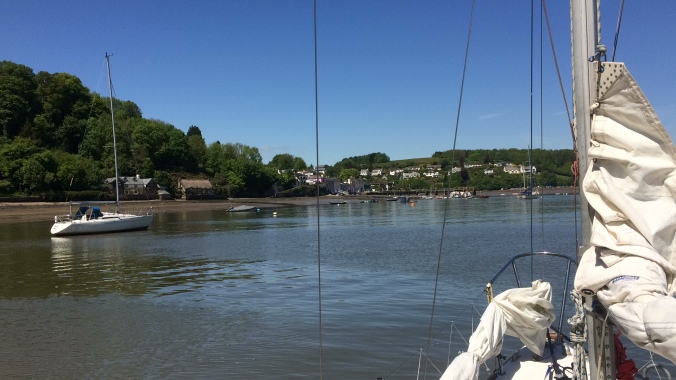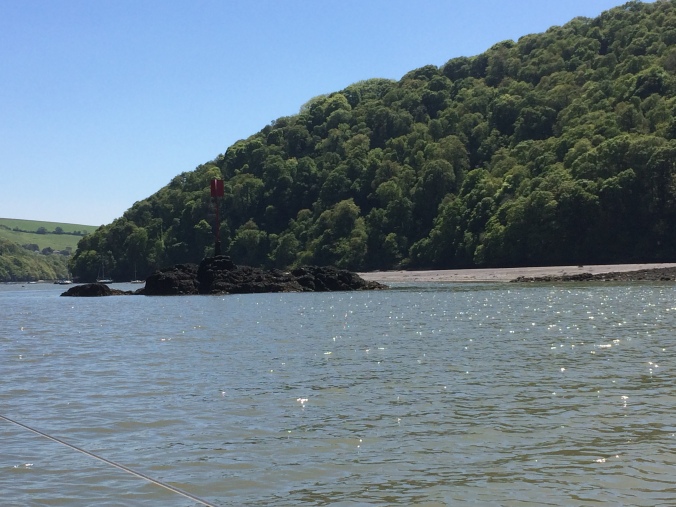‘Blue Mistress’ still lives. A long winter onshore, a delay of a month while the weather settled and back on the mooring at the end of April – complete with new engine, bigger and, hopefully, more reliable than the previous one. Yes, I know, she’s a sailing boat, but that doesn’t mean the wind blows all the time, nor is the tide always favourable in tight situations.
Last Monday, under strict instructions to be back by Wednesday evening at the very latest (!), I motored to Dartmouth – some 16 nautical miles along the coast. No wind, glassy sea, pure blue sky, high spring tide. Would I have preferred to sail there? Of course. Did it matter that I didn’t? Not one jot.

Berry Head with its old quarries
The passage has three stages – Teignmouth to Hope’s Nose, across the entrance to Torbay, then Berry Head to Dartmouth. The coast is varied and beautiful, from the red cliffs around Teignmouth, to the towns and villages of Torbay, and on to the rugged, grass and gorse lined clifftops towards Dartmouth. The tide was with me all the way. Three and a half hours.
A comfortable night in Dartmouth itself, on an unusually empty visitors’ pontoon – just three other unoccupied yachts. The evening sun picked out the houses of Kingswear, the morning sun shone on Dartmouth town.
The weather forecast gave the possibility of rain and adverse winds on the Wednesday – (there was a time when that would have been fun, but . . .), so the decision to return today, accepting the tide would be against me. But first, how about going up the River Dart to Dittisham?

The boathouse at Greenway – Agatha Christie’s home
The tide is ebbing and I reach Dittisham at slack low water, picking up a visitors’ mooring and enjoying lunch in the heat and quiet of the day.

Dittisham from the mooring
An hour later the tide is turning and I motor as far as I dare upstream before heading back down towards the sea.

The quay at Greenway across the river from Dittisham

Dittisham itself at low water

The Anchorstone – the channel is to the left, a surprising 23 metres on my depth sounder.

‘Grayhound’ is in port – a wave from the hand up the mast, Kingswear beyond

A new shipmate – Berry Head in the middle distance.
The sea was flat, the adverse tide along the coast strong, and eddies and swirls from deep rocks and reefs evident on the surface. It took an extra hour to get back to Teignmouth.
One mile from home, the wind got up, gusting straight out of the entrance to the estuary, throwing up steepish waves and spray against the flood tide. One moment all was peace, the next excitement. I was unsure whether my mooring lines would be free or tangled round the buoy so I had rigged a long bow line bringing the end outside the rigging back to the cockpit. I have two lines attached to the buoy – a short, ‘quick’ line with a loop to slip over the mooring cleat, (instantly holding the boat at the right distance from the buoy), and a longer, stronger one, which, once cleated, will take the weight of the boat. In the event, the lines were flowing free as we shot past. Rounding up into the the tide, for a few seconds we were side on towards an approaching Shaldon bridge – a bridge with no mast clearance.
Now the tricky bit, how much engine to I need to bring her more or less to a halt alongside the buoy, allowing me enough time to go forward with the boat hook, sweep the lines out of the water and slip the loop over the cleat? I approach the buoy, nudging slightly to starboard and go forward quickly. The buoy is now about three feet along the starboard bow and I note we are still moving forward slightly. Pleasingly the boat hook picks up both lines at once and I am able to bring them forward over the bow roller and place the loop. The boat is still moving forward and is beginning to drag the buoy – back aft to put the engine out of gear and allow the boat to drift back with the tide and settle to the ‘quick’ line. Then forward again to make the second line fast, then aft to shut down the engine. All is quiet, the wind is still blowing and the tide flowing but we are safely moored. A great day with a lively ending.
And the engine is good – a Beta 14. A mite ambitious? Perhaps. A tight squeeze into this small boat? Certainly. Anathema to the purists? Without a doubt. But without it I wouldn’t have known the sheer joy of these two days on the water.
(Images by Bill Whateley)